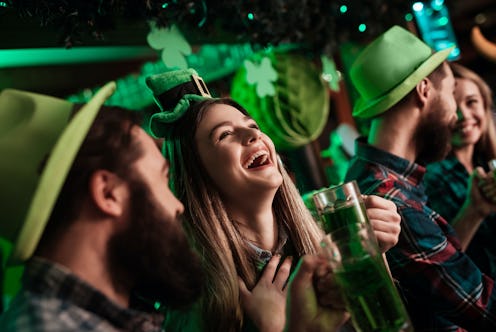St. Patrick's Day
Why Do We Wear Green On St. Patrick's Day?
The original color was actually blue.

I don’t know about you, but every time March rolls along, I always find myself scrambling to find something green in my wardrobe in time for St. Patrick’s Day. The color has become synonymous with the Irish holiday, and you’ve probably never questioned why that is. The Irish flag is ⅓ green, after all, and there’s so much shamrock imagery tied to St. Patty’s Day that the tradition of wearing all green everything on March 17 just makes sense. But there’s a long history behind the reason why we wear green on St. Patrick’s Day, as well as other facts about the holiday, like why leprechauns are such a big part of St. Patty’s Day.
It turns out there’s no one reason why green is the color of choice for the holiday. Rather, a handful of different reasons and lore combined and adapted over time resulting in St. Patrick’s Day being associated with the color green. According to National Geographic, the original color of St. Patrick's Day was blue. However, as Nat Geo notes, green was adopted by St. Patrick’s Day festivities in the 18th century after the shamrock became Ireland’s national symbol. Additionally, green began to dominate based on Ireland’s nickname "The Emerald Isle," which was popularized in part because of the country’s lush landscape, per USA Today.
There are also political ties to the color green. As Brian Witt, the cultural exhibits coordinator for the Milwaukee Irish Fest, told USA TODAY, green is associated with Irish nationalism. King George III introduced the Order of St. Patrick, named for the saint who was often depicted dressed in blue, according to Smithsonian Magazine. After the divide between the Irish people and the British monarchy grew, the people of Ireland wanted to separate themselves from Britain and moved away from the color blue. Thus, the color green became a symbol of rebellion in Ireland, per Smithsonian Magazine.
The shamrock as a symbol of Ireland and St. Patrick’s Day also has a religious history. As National Geographic reports, some believe the shamrock represents the Holy Trinity — the three leaves symbolize the father, son, and the holy spirit. They were also used by St. Patrick to teach others about the basics of the Holy Trinity, per Nat Geo. Thus, it makes sense to represent the shamrock by wearing green, to pay tribute to the religious aspect, the seasonal aspect, and to the man himself.
Now, onto the leprechauns. There has been debate about whether leprechauns are offensive, specifically when thought of as a depiction of the Irish. To be clear, reducing a group of people down to a singular outfit or icon generally gets dicey. However, the leprechaun does have ties to Irish folklore. Per History, leprechauns are likely based on Celtic fairies, small creatures called “lobaircins” known for stirring magic and mischief. That eventually evolved into leprechauns pinching those who aren't wearing the color, per Nat Geo, which has developed into others pinching people to remind them that leprechauns wouldn't approve of their non-green apparel. As someone who hates being pinched, this is reason enough to throw on a green shirt. The latter is actually an American-based tradition, per Christian Science Monitor, as leprechauns were first imagined to have been wearing red jackets and red, pointed hats, both free of shamrocks.
It's amazing to see how much the holiday has evolved. Back in the day, only those in Ireland celebrated St. Patrick's Day, and it usually included a feast and a trip to church. Now, it's celebrated with green clothes, drunken debauchery, and immense pride of the country — after all, everyone's a little bit Irish on St. Patrick's Day. As you wear your green clothes and drink your green beer (or green mocktails) at your favorite bar this holiday, remember why green is such a powerful color — not only will it save you from getting pinched by a stranger, but it'll remind you of the rich history of Ireland.
This article was originally published on